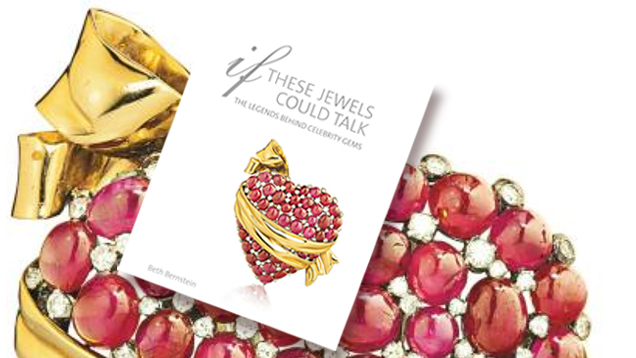Book Review: If These Jewels Could Talk: The Legends Behind Celebrity Gems

Beth Bernstein’s If These Jewels Could Talk is a lush visual treat for anyone interested in the history of cinema, important jewelry and gemstones, and the place of powerful women in Western culture. The timeless jewelry pieces, by some of the biggest names in the jewelry industry, almost outshine the celebrities who owned and wore them.
While the book showcases some spectacular jewelry owned by wealthy socialites (Barbara Hutton), women close to royalty (Wallis Simpson), and actual royalty (England’s Queen Elizabeth and Princess Diana), the primary focus is on pieces worn and treasured by Hollywood’s leading ladies. Although Bernstein touches on the actresses of today, they are overwhelmed by the tribute she pays to the iconic films of the 1930s, ’40s, and ’50s that starred women who are still synonymous with glamour: Mae West, Carole Lombard, Merle Oberon, Grace Kelly, Elizabeth Taylor, and Audrey Hepburn. This book belongs to them.
With such an eclectic mix of jewelry and stars, organization might present a challenge, but Bernstein has logically divided the book into 14 chapters. The first five are organized by gemstone: Sapphire Sirens, Emerald Enchantresses, Ruby Romantics, Diamond Divas (with a subheading “Diamonds Are Forever,” featuring engagement diamonds), and Pearl Girls. A surprise from the sapphire chapter was the popularity of enormous star sapphires in the 1930s and ’40s).
- Sentimental Journeys (jewelry given as wedding or love gifts, and charm bracelets)
- Real to Reel (jewelry used in films and created for films)
- Screen to Street (pieces featured in films that created a demand in the market place)
- Owning It (jewelry owned by actresses and worn by them in numerous films)
- Building Character (jewelry that played a significant part in films, such as the ruby and diamond necklace worn by Julia Roberts in Pretty Woman, or Audrey Hepburn’s diamonds in Roman Holiday)
- Time Keepers (wrist watches in film)
- Credits Roll (the role jewelry houses played in supplying pieces for film and the reciprocal impact of those pieces on the houses’ reputations)
- Powerful Passionates (pieces purchased and commissioned by the women themselves)
- Bring On the Brands (capsule histories of some of the biggest jewelry houses in the world)
The stories are delightful, romantic, and occasionally sad: Mike Todd’s surprise recreation, in diamonds, of Taylor’s paste earrings; Mae West’s husband’s refusal to sell her jewelry after her death, despite his own financial need; Edward VII’s presentation to Wallis Simpson of cross charms marking significant points in their courtship.
If These Jewels Could Talk is somewhat marred by poor sentence construction and muddy wording that confuses and distracts the reader. (Referring to the Duchess of Windsor’s panther clip brooch, for example: “This classic Cartier sapphire is set in white gold and platinum with single-cut white diamonds. It has yellow pear-shaped diamond eyes with smaller sapphire cabochons for the feline’s spots.”) Such flaws could have been eliminated by a careful final edit.
In reality, the text is secondary to the photos of brilliantly designed jewelry, such as Merle Oberon’s breathtaking emerald and diamond necklace, the hand jewelry designed for the 2013 big-screen version of The Great Gatsby, and just about anything that belonged to Elizabeth Taylor. The glamour shots of actresses wearing their pieces are captivating. (A personal favorite is the image of Carole Lombard with a magnificent star sapphire clipped to a hat. The star is sharply lit and brilliant—even in black and white.) Also contributing to the visual feast are the drawings produced by the jewelry houses of jewels such as the neckpiece that would eventually showcase Taylor’s La Peregrina pearl.
More than anything, this book is a reminder that jewelry bespeaks power and always has. And these women had real power: sexual power to inveigle men to buy important jewelry for them, power to influence market demand and fashion trends, financial power to purchase their own jewelry, and (in the case of Wallis Simpson) political power.
For this alone, this unforgettable image of women of power, this large-format, high-quality coffee-table book is highly recommended.



